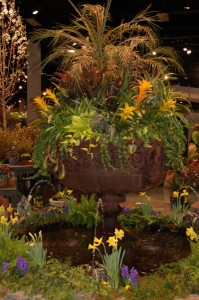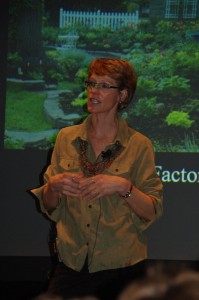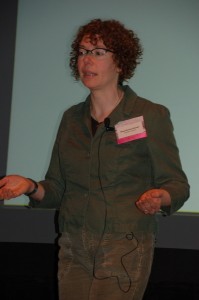Click image for photo gallery
 Probably the last time I went to the Boston Flower & Garden Show it was at the Bayside Expo Center. It’s been many years. On Thursday, I drove into Boston to the Seaport World Trade Center and arrived around 10:15 when the initial mad rush was over, so the drive, parking, and buying a ticket was easy going.
Probably the last time I went to the Boston Flower & Garden Show it was at the Bayside Expo Center. It’s been many years. On Thursday, I drove into Boston to the Seaport World Trade Center and arrived around 10:15 when the initial mad rush was over, so the drive, parking, and buying a ticket was easy going.
This part of the city is much nicer than I remember it. The layout of the trade center was easy to navigate although for a week day, the crowd was sizeable. Hate to think what the weekend was like! But gardeners are a nice crowd and very polite.
The theme of this year’s show was: “A Burst of Color: Celebrating the Container Garden.” Container gardening in the past ten years has expanded from just a few flower pots on your deck to large containers displaying sophisticated combinations of annuals and perennials, spanning the seasons on your deck or as part of your landscape. It can also allow you to have a vegetable garden when you don’t have the room or perhaps the time or energy for a traditional garden.
The show included over 25 display gardens created by the area’s top nurseries, landscapers, professional florists, and horticultural associations. The gardens each featured at least one focal container of some kind, such as a topiary, raised beds, built-in planters, or unusual items used as containers (i.e. garbage can). Lectures and demonstrations offered planting tips and design ideas for fruit, vegetable and ornamental containers.
Several rooms near the main trade center floor housed the creations of the region’s top amateur floral arrangers. Their colorful and often innovative arrangements were coordinated and judged by the Massachusetts Horticultural Society and the Garden Club Federation of Massachusetts.
I attended three lectures and a demonstration, which I describe below.
Lecture: Open Mike – Paul Miskovsky, Kerry Mendez, Roger Swain
Roger Swain hosted the PBS show The Victory Garden in the 1980’s and 90’s. He has written several books on gardening and is the co-host of the television show “People, Places, and Plants” with Paul Tukey on HGTV at 7 am on Sunday mornings.
Paul Miskovsky is owner of Miskovsky Landscaping in Falmouth with decades of experience and winner of numerous awards from regional flower and garden shows. His website is www.miskovskylandscaping.com .
 Kerry Mendez is owner of a garden installation and consulting business, Perennially Yours, which focuses on gardens in zones 3 – 5. She is the author of two gardening books and numerous articles. Her website is www.pyours.com .
Kerry Mendez is owner of a garden installation and consulting business, Perennially Yours, which focuses on gardens in zones 3 – 5. She is the author of two gardening books and numerous articles. Her website is www.pyours.com .
___________________________________________________________________________________
Roger Swain began the Question and Answer session by saying that the best way to learn about gardening was from other gardeners and encouraged the audience to attend a Master Gardeners Program.
Most of the questions centered on how to get rid of pests, such as insects and invasive plants.
Question: How do you trim a butterfly bush?
Answer: After it has finished blooming, trim to 18 to 24 inches. To protect it in winter in a cold climate, such as Zone 4 or 5, surround it with chicken wire and pack leaves around the trunk.
_____________________________________________________________________________________
Question: How can you get rid of the Red Lilly beetle, which destroys Asiatic lilies?
Answer: Use Spinosad, which is found in products such as Capt. Jack’s Dead Bug, which is organic. Use it when you see the Red Lily beetle eggs, which are bright orange and found on the underside of a leaf. This will also kill Japanese beetles.
____________________________________________________________________________________
Question: What’s an organic way to get rid of Creeping Charlie that is taking over a lawn?
Answer: Mix up a paste with 20 Mule Team Borax and then mix that with 2½ gallons of water. Spray that over the lawn. It shrivels the plant and will be gone within a week.
____________________________________________________________________________________
Question: How do you get rid of Vine Weed and other invasive plants such as Bishop’s Mantle?
Answer: An organic method is to spray the plants with a product called Nature’s Adventure or strip the plant. A non-organic method is to mix 2 parts full strength Roundup with 1 part water. Dip the pruner in the solution and trim the stems of the plant. The solution travels from the stems to the roots, which kills the plant.
1:30 Lecture: Perennial Plant Collector’s Corner – Kerry Mendez
Kerry specializes in creating low maintenance, ever blooming gardens. She has written two books:
- The Ultimate Flower Gardener’s Top Ten Lists – 70 Garden-Transforming Lists, Money Saving Shortcuts, Design Tips & Smart Plant Picks for Zones 3-7
- Top Tens for Beautiful Shade Gardens – 52 Garden-Transforming Lists for Smart Plant Picks, Design Tips & Garden Shortcuts.
Both these are available at her website, www.pyours.com, and probably Amazon as well. I looked through these books at the show’s bookstore and they both looked excellent – entertaining and informative as well as easy to read. They’re the kind of books you can flip through and find useful tips no matter which page you land on.
Kerry said she likes to get the most from each plant in her garden by making sure that each one offers at least two seasons of interest, such as flowers in the spring and interesting foliage for summer.
She said it’s important to replenish garden soil each year by:
- Fertilizing with 5-5-5 or 5-10-5 product in spring (2 lbs./100 sq. ft.) before it rains, or
- Using a nutrient rich feeding mulch after the plant is growing. Use aged compost or aged manure type mulch – it breaks down faster.
It’s also good to divide plants so they don’t crowd out an area, to expand the garden in other areas or to share with others. For spring-blooming plants, divide after they’ve bloomed. For summer and fall bloomers, divide in the spring, before they bloom.
She then went on to discuss 43 perennials that she considers new, unusual, or underused. These probably can be found in her books or on her website. Here are five that looked interesting:
- Smooth Phlox (Phlox glaberrima) ‘Triple Play’; sun – part sun; spring bloomer; 12-18” tall; Zones 4 – 8. This is a fragrant plant with lavender blue flowers. Use it instead of Creeping Phlox. It’s drought tolerant. You can shear off the spent flowers after blooming. The foliage blocks weeds during the rest of the season.
- Bellflower (Campanula poscharskyana) ‘Blue Waterfalls’; sun-part sun; summer bloomer; 8-10” tall; zones 3 – 7. This is the best bellflower because it blooms the longest, is heat tolerant, and is drought resistant.
- Perennial Bachelor Button (Centaurea Montana) ‘Amethyst in Snow’; sun; summer bloomer; 14” tall; zones 3 – 9; deer resistant. This flower has striking white petals with a dark purple center.
- Astilbe ‘Colorflash’; sun – part shade; summer bloomer; 10-12” tall; zones 4 – 8; deer resistant. The foliage provides great fall color.
- Corydalis ‘Berry Exciting’; part shade – shade; summer bloomer; 10-13” tall; zones 5 – 9. This plant is a work horse – it blooms from May through the fall. Its lavender flowers contrast nicely with the bright yellow leaves.
Demonstration: The Best Container Gardening Plants 2011 – Barbara Pierson, Nursery Manager, White Flower Farm; www.whiteflowerfarm.com/
 The White Flower Farm in Litchfield, Connecticut grows 800 species of plants in over 30 greenhouses. They are a mail order as well as retail business. Each month their 300 foot border displays a different swath of color, such as purple (hyacinths) in May which then turns to white (wisteria, iris) in late May depending on the temperature. Barbara thinks focusing on a particular color in a season adds drama and impact.
The White Flower Farm in Litchfield, Connecticut grows 800 species of plants in over 30 greenhouses. They are a mail order as well as retail business. Each month their 300 foot border displays a different swath of color, such as purple (hyacinths) in May which then turns to white (wisteria, iris) in late May depending on the temperature. Barbara thinks focusing on a particular color in a season adds drama and impact.
She discussed nearly thirty plants for container gardens that she thinks will be top sellers for 2011. Here are ten:
Begonia BIG Red with Bronze
Calibroacha Superbells Saffron
Lantana Landmark Rose Sunrise
Verbena bonariensis
Petunia Supertunia Vista Bubblegum
Ipomoea batatas Margarita
Fuschia ‘Billy Green’
Impatiens Sunpatiens Variegated
Nicotiana alata
Coleus Twist & Twirl
Here are some recommended container plant combinations:
“Foliage with Flair”:
Begonia BIG Red with Bronze
Caladium ‘Florida Cardinal’
Coleus ‘Mint Mocha’
Ipomoea ‘Sweet Caroline Light Green’
Asparagus densiflorus ‘Sprengeri’
“Jazz Festival”:
Angelonia ‘Angelmist Purple Stripe’
Calibroacha Superbells Saffon
Calitunia purple
Lantana Landmark Rose Sunrise
Nemesia fruticans ‘Bluebirds’
“Hummingbird”:
Fuschia ‘Billy Green’
Begonia ‘Dragon Wing Pink’
Coleus ‘Sedona’
Coleus ‘Strawberry Drop’
Ipomoea batatas Margarita
Lecture: Photographing Your Garden Like a Pro – Cheryl Collins, Photographer, www.picturethispresents.com/
Cheryl Collins has been a freelance photographer for almost 30 years and was state photographer for the Garden Club Federation of Massachusetts for 6 years. She lectures to garden clubs throughout New England.
Cheryl offered the following advice:
- Good photography is about perspective; it’s what appeals to you, such as detail and texture. Your vision is translated through the camera.
- Learn what your camera can do, such as a macro setting for close ups.
- Break the picture into thirds.
- Determine what your goal is, such as whether you want to photograph the flower vs. the whole plant.
- Vertical vs. horizontal: What are you looking for – the expanse of a garden or just a particular plant.
- Lines such as those created by a stone wall or a fence guide the eye into a scene. Also, something in the foreground also draws the eye in.
- Cloudy days are best for even lighting. Make sure sun is at your back, never face it – causes glare.
- Use flash in the shade.
- Get closer to eliminate distraction.
- With digital photography, don’t be afraid to over shoot – it doesn’t cost anything like film used to!
- Dew drops on a flower or a spider web makes for a more interesting photograph. You can cheat by spraying the plant or web with a spritz bottle.
Lecture: Origins of Boston’s Parks and Gardens – Meg Muckenhoupt, Garden Writer
 Meg Muckenhoupt is author of Boston Gardens and Green Spaces. She edits the Belmont Citizens Forum Newsletter, and has written for Boston Magazine, the Boston Globe, and the Boston Phoenix.
Meg Muckenhoupt is author of Boston Gardens and Green Spaces. She edits the Belmont Citizens Forum Newsletter, and has written for Boston Magazine, the Boston Globe, and the Boston Phoenix.
Meg packed a great deal of information in a short amount of time. She loves history and has covered this topic comprehensively in her new book. Here are some interesting facts she revealed in her talk:
The Boston Public Garden started out as mud flats in the 1600s and 1700s.
Landfill began in 1795 with the creation of wharves on Boston Harbor.
In 1847, 37000 Irish immigrants arrived. Wealthy Bostonians started running out of land. In 1852, the Back Bay was created for them using landfill, such as gravel and old bottles as well as soil from three mountains – Tri Mountain area – that is now Tremont Street.
In the Back Bay, the broad tree-lined boulevards and mansard roofs of buildings on the Commonwealth Avenue Mall was inspired by Paris of the 1860’s and were designed to attract the wealthy.
The Mill Dam was built in 1910 to harness the power of the tides that flowed in and out of the Charles River.
Horace Gray, known as the father of the Boston Public Garden, spearheaded the early effort to transform the mudflats on the western end of the Boston Common into the Boston Public Garden. The botanical garden he created in 1837 was the first place in the United States to grow tulips. George Meacham won the public design competition for the garden.
Frederic Law Olmstead designed the Back Bay Fens and Franklin Park. He created Franklin Park for the ordinary working citizen to escape the stressful life of the city. It once had sheep.
The Fenway Victory Gardens were created from soil dug out to create the Park Street Station.
Piers Park, which opened in 1995, was created, in part, to compensate the East Boston community for the destruction of their park in the 1960’s when Logan Airport was built.
Millenium Park in West Roxbury was created from soil from the Big Dig. It is popular with birdwatchers.
